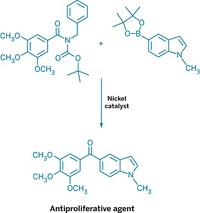Advertisement
Grab your lab coat. Let's get started
Welcome!
Welcome!
Create an account below to get 6 C&EN articles per month, receive newsletters and more - all free.
It seems this is your first time logging in online. Please enter the following information to continue.
As an ACS member you automatically get access to this site. All we need is few more details to create your reading experience.
Not you? Sign in with a different account.
Not you? Sign in with a different account.
ERROR 1
ERROR 1
ERROR 2
ERROR 2
ERROR 2
ERROR 2
ERROR 2
Password and Confirm password must match.
If you have an ACS member number, please enter it here so we can link this account to your membership. (optional)
ERROR 2
ACS values your privacy. By submitting your information, you are gaining access to C&EN and subscribing to our weekly newsletter. We use the information you provide to make your reading experience better, and we will never sell your data to third party members.
Synthesis
Gentle Route To Diazos
Wisconsin chemists report a phosphine reagent for converting azides to diazo compounds
by Celia Henry Arnaud
December 8, 2008
| A version of this story appeared in
Volume 86, Issue 49

Diazo compounds are versatile intermediates in organic synthesis, but they are typically difficult to generate. Chemistry professor Ronald T. Raines and postdoctoral associate Eddie L. Myers of the University of Wisconsin, Madison, report a gentle high-yield method to generate diazo compounds, R=N2, from azides, RN3 (Angew. Chem. Int. Ed., DOI: 10.1002/anie.200804689). The key to the reaction is an ester-containing phosphine reagent that reacts with azides to form phosphazides. An intramolecular acylation traps the phosphazide, which forms an acyl triazene upon hydrolysis. In the presence of a weak base, such as sodium bicarbonate, the acyl triazene fragments into a diazo compound and a primary amide. The researchers manage to bypass the Staudinger reaction, which uses similar starting materials to make amines, by using a strong acylating group. "Having a phosphine with a highly active acylating group allows us to do this chemistry," Raines says. The reaction works well for α-azido amides and esters but not as well for α-azido ketones because they fragment and form acyl hydrazones. Raines and Myers are currently developing water-soluble phosphine reagents to extend the methodology to chemical biology applications.





Join the conversation
Contact the reporter
Submit a Letter to the Editor for publication
Engage with us on Twitter